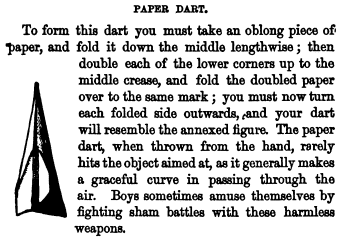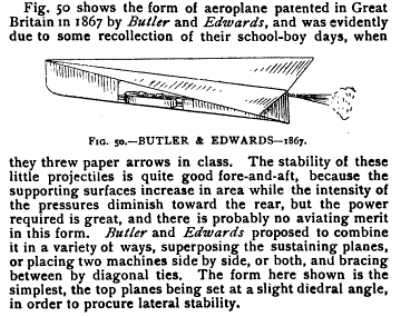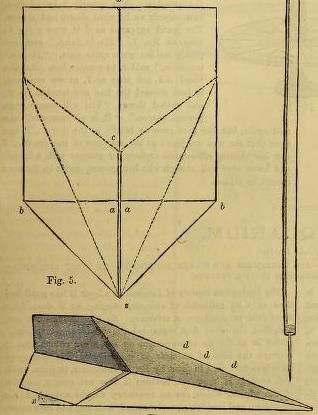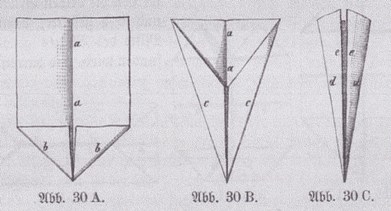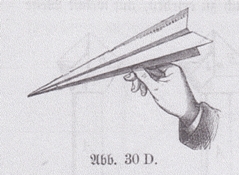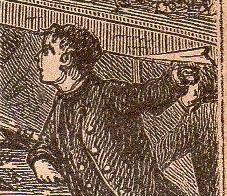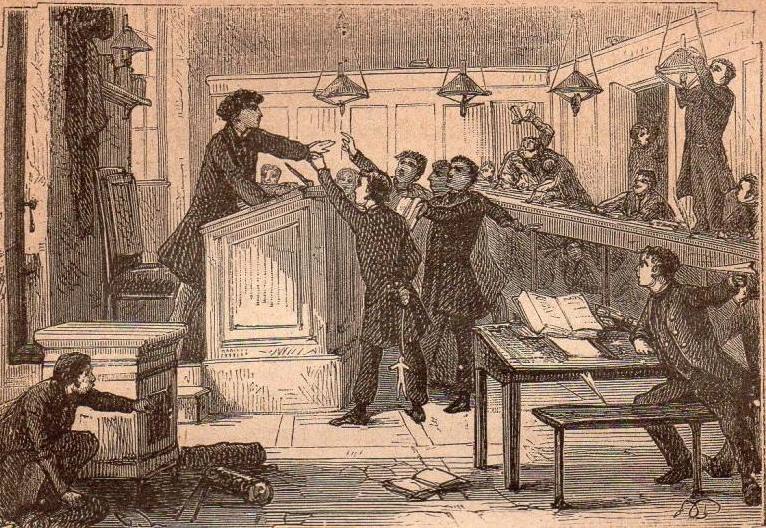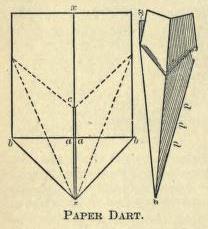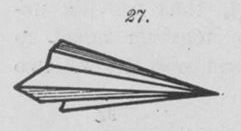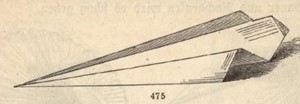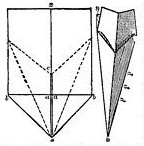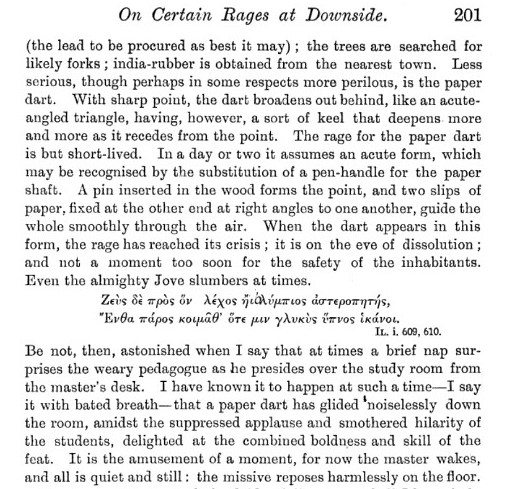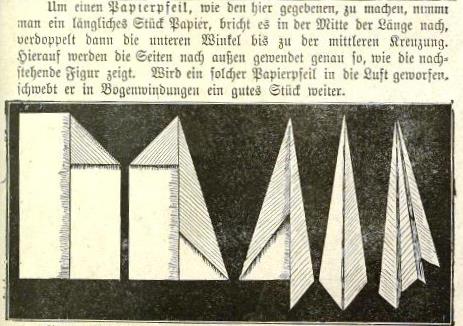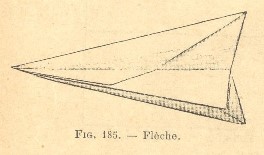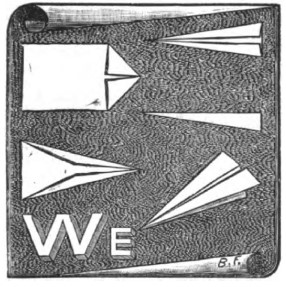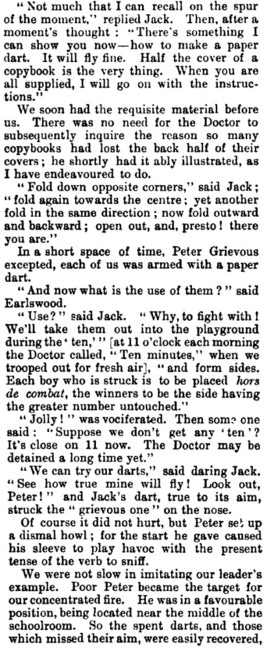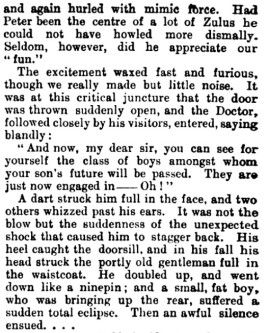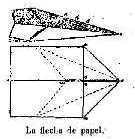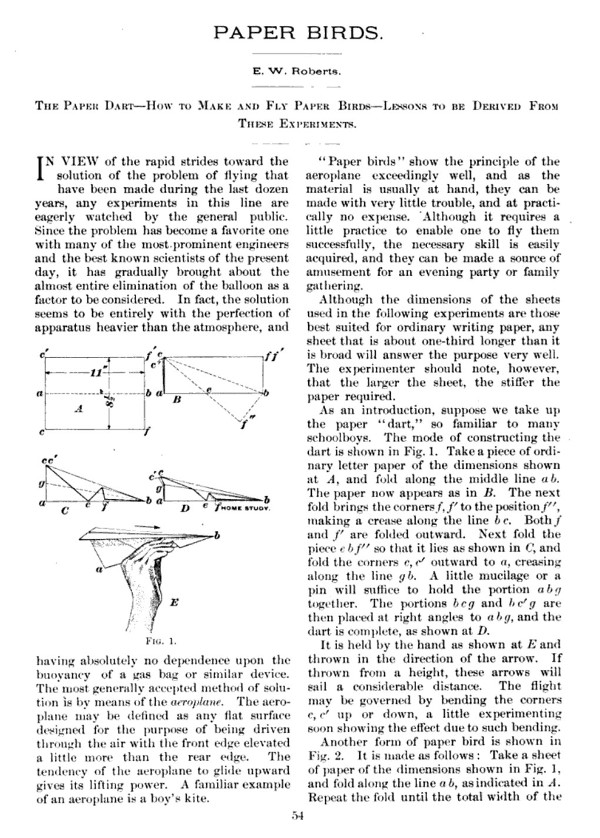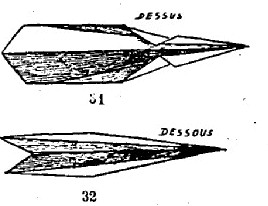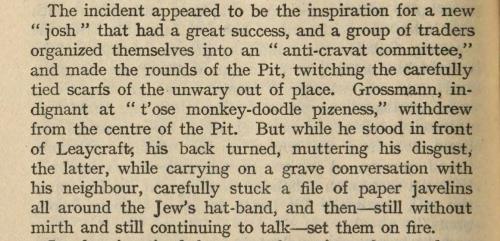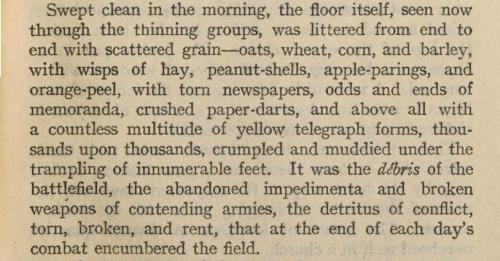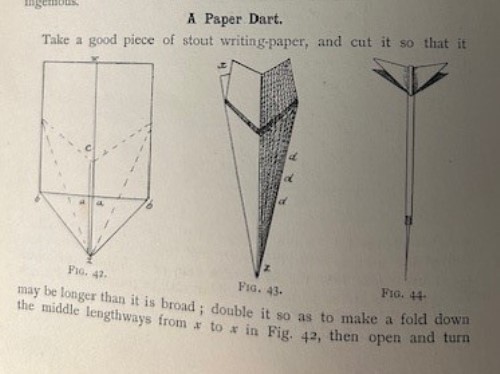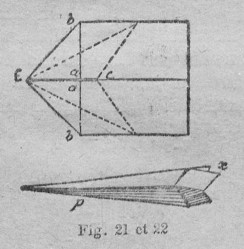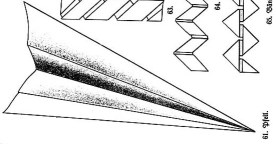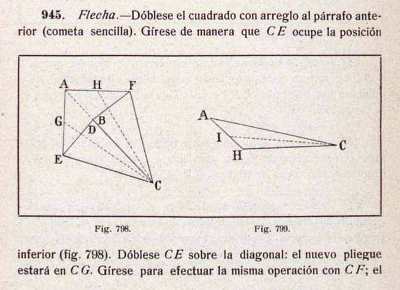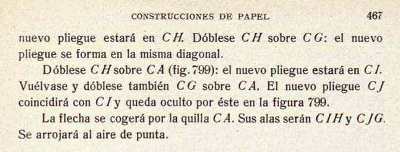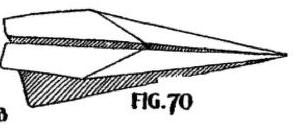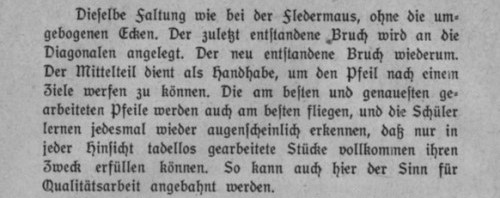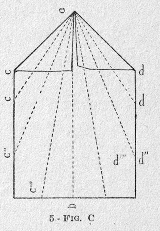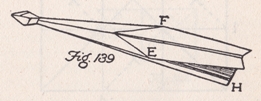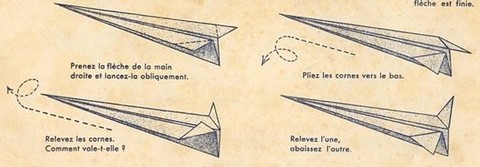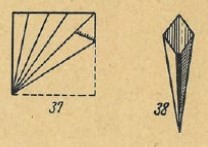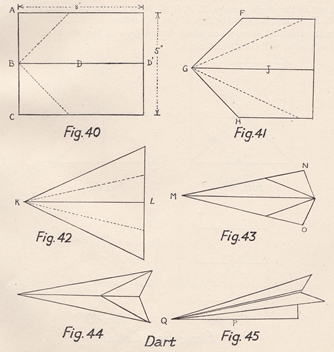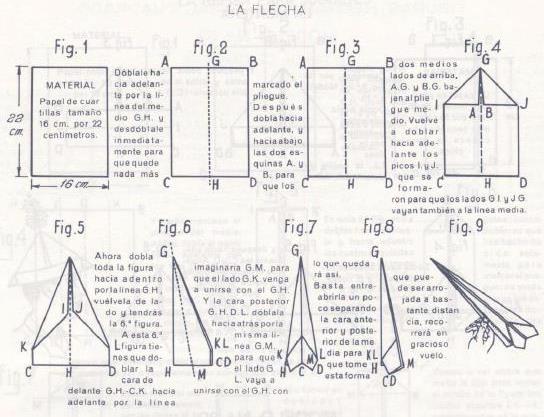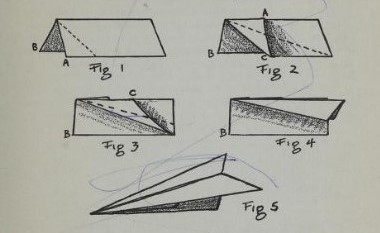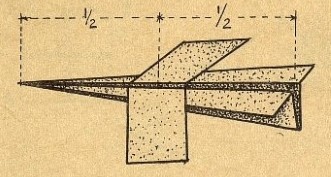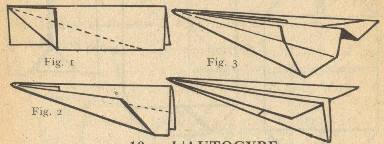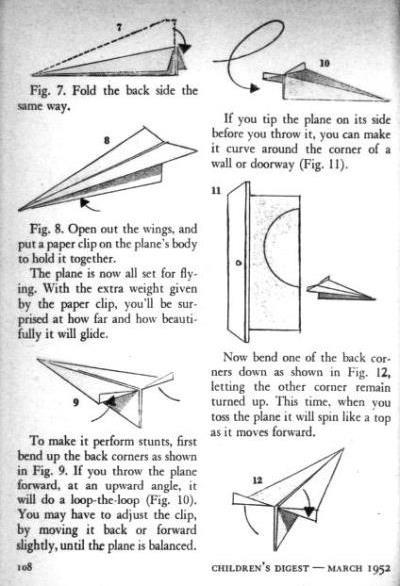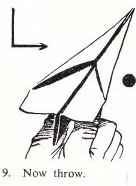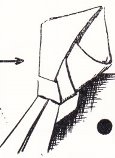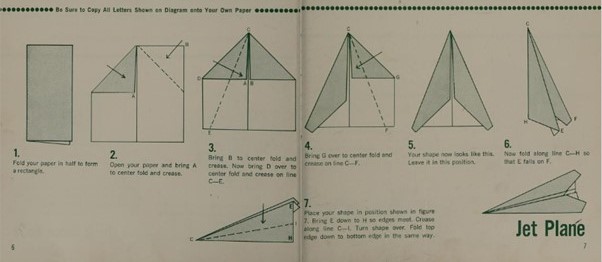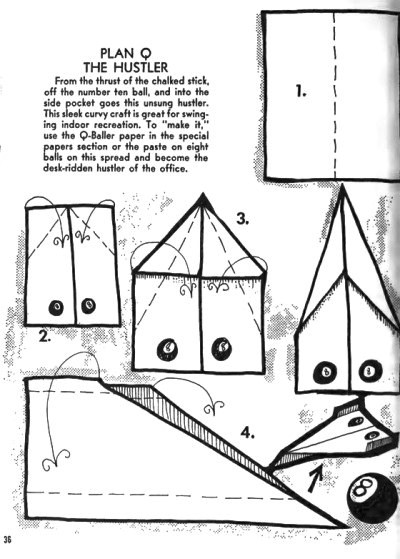| The Public Paperfolding History Project
Last updated 4/8/2025 x |
|||||||
| The Paper Dart / The Paper Arrow | |||||||
| This
page is being used to collect information about the
history of the paperfolding design known as the Paper
Dart or the Arrow. Please contact me if you know any of
this information is incorrect or if you have any other
information that should be added. Thank you. The Paper Dart is nowadays considered to be a paper plane, but, as its early names suggest, it was not viewed as a paper plane when it was first designed. There are three passages in the literature which refer to paper darts being thrown or stuck into schoolmaster's wigs, dated 1786, 1828 and 1835 respectively. There are no accompanying illustrations to identify the nature of these paper darts, but it seems to me that, taken as a whole, these passages clearly refer to the Paper Dart / Arrow design. In particular the words 'I placed them between my forefingers' in the 1828 passage seem sufficient to show that the paper-darts in question were thrown by hand. They were not therefore small paper cones shot from a blowpipe. The only other remaining possibility is that they were wooden darts fitted with paper flights, but these would, I think, make too much of an impact on landing in a wig to make it possible for their arrival to go unnoticed. The 1786 reference is presented as a contemporary story. The 1835 reference states 'This was about the year 1786'. The 1828 reference says that the incident occurred 'Very many years ago'. It seems, therefore, that throwing Paper Darts into schoolmasters wigs was a common occupation for schoolboys at that time. Information on other kinds of paper darts can be found here. The Paper Dart was originally folded from an oblong. The same design folded from a square seems to be a Japanese variation. ********** In Japan and in publications by Japanese authors In his article 'History of Origami in the East and the West before Interfusion', published in 'Origami 5: Fifth International Meeting of Origami, Science, Mathematics and Education' in 2011, Koshiro Hatori asserts that, ''Many of the European origami models contained in Krause-Boelte's book (ie 'The Kindergarten Guide') are not included in contemporary Japanese records. The pig, house, sofa (also known as piano or organ), balloon (waterbomb), arrow (paper plane), salt cellar (cootie catcher), bird (pajarita or cocotte) and windmill ... were all born in Europe and imported into Japan along with the kindergarten system.' ********** 1931 As far as I know the first appearance of this type of design in Japan is in 'Origami (Part 1)' by Isao Honda, which was published in 1931, although you will note that in this instance it is folded from a square rather than an oblong.
********** 1944 The same variation appears in 'Origami Shuko' by Isao Honda, which was published in 1944.
********** In Europe and the Americas 1786 The September 1786 issue of 'The European Magazine and London Review' contains a story written by R Cumberland Esq, titled 'The Advantages of Public Education exemplified in the Story of Geminus and Gemellus', which contains passages referring to paper darts being stuck in a preceptor's wig. In the same year the story was also published in the third volume of 'The Observer' and in the October 1786 issue of 'Walker's Hibernian Magazine'. The relevant passages (taken from 'The Observer' (which is easier to read) are:
********** 1794 An obituary for William Kitchiner, which appeared in the July 1794 edition of The Gentleman's magazine, includes a paragraph concerning his son who lost an eye to a 'paper arrow, armed with a pin'. I have presumed that this 'paper arrow' was a Paper Dart, although there is no other known reference to a Paper Dart being 'armed with a pin' in this way.
********** 1807 A paper dart is mentioned in 'Ten Epistles of Ovid, Translated into English Verse' by Rev, Wm Windsor Fitzthomas was published in London in 1807. It contains reference to a paper dart. The mention of this paper dart is only in the English 'translation' and corresponding words do not appear in the Latin original.
********** 1828 Part 1 of 'Parriana' by E H Barker, which was published by Henry Colburn in London in 1828, contains two passages referring to 'twisted papers' and 'paper-darts' being thrown into a large wig worn by a school teacher.
The second passage states that the incident described occurred 'Very many years ago', however no more specific date is given.
********** 1835 A somewhat similar passage appears in 'Memoirs of Charles Mathews, Comedian' which was written (or perhaps only edited) by his wife, Anne Jackson Mathews, and was published by R Bentley in London and Lea and Blanchard in Philadelphia in 1839 four years after Mathew's death in 1835. Page 30 of Volume 1 of the Philadelphia edition states 'and we shot paper-darts' into the head master's wig so 'that it looked like a fretful porcupine'. This activity is dated to 'about the year 1786' when Mathews would have been 10 years old.
********** 1859 The first illustration of, and instructions for making, the Paper Dart that I know of are found in 'Games and Sports for Young Boys', which was published by Routledge, Warne and Routledge in London and New York in 1859.
********** 1864 An illustration of 'Ein Warfpfeil' (A Dart) appears in 'Spielbuch fur Knaben' by Hermann Wagner, which was published by Verlag von Otto Spamer in Leipzig in 1864, although the foreword is dated May 1863, which argues that the book was complete at that date. As far as I can tell there are no accompanying diagrams or instructions in the book.
********** Written instructions for folding the Paper Dart are also found in Every Little Boy's Book, published by Routledge, Warne and Routledge in 1864.
********** 1865 The illustration that appeared in 'Spielbuch fur Knaben' by Hermann Wagner also appears in 'Spielbuch fur Madchen' by Maria Leske (a pseudonym of Marina Krebs), which was published by Verlag von Otto Spamer in Leipzig in 1865. ********** 1867 A patent for an aeroplane based on the Paper Dart was issued in London in 1867.
********** 1869 As 'Pijl' in 'De Kleine Natuurkundige' by Pieter Beets, which was published by D Noorthoven Van Goor in Leiden. The work is undated but said to be from 1869.
********** 1873 The earliest diagrams that I know of for a Paper Dart appear in The Popular Recreator', which was published by Cassell and Co in London in 1873.
********** The third edition of 'Der Kindergarten' by Hermann Goldammer, which was published by Carl Babel in Berlin in 1874, mentions, but does not picture, a design titled 'Der Pfeil' (the arrow). From the name and the context this is probably the Paper Dart. ********** 1876 Diagrams also appear in 'Des Kindes Erste Beschaftigungsbuch' by E Barth and W Niederley, which was first published in Bielefeld and Leipzig, and the foreword of which is dated October 1876.
********** 1877 A Paper Dart can be seen in this illustration of chaos in a classroom, taken from the 1877 edition of 'Histoire d'un Enfant' by Alphonse Daudet, which was published in Paris by J. Hetzel et Cie. Design by P. Philippoteaux and engraving by Laplante.
********** 1880 Diagrams for the Paper Dart, under the title 'Les Fleches', also appear in 'Un million de jeux et de plaisirs' by T de Moulidars, which was first published in 1880 and subsequently republished under the title 'Grande encyclopédie méthodique, universelle, illustrée, des jeux et des divertissements de l'esprit et du corps' in 1888. ********** 1881 Diagrams also appear in 'Cassell's Book of Indoor Amusements, Card Games and Fireside Fun', which was published by Cassell and Co in London in 1881. The introduction states, 'The paper dart is one of the easiest made of the paper toys, and when made will last some time, if put only to its legitimate use. It is best made of a piece of good, stout paper ...''
********** In his book 'Paper: Paging Through History', Mark Kurlansky reports that 'In 1881, the New York Stock Exchange declared it would impose a dollar fine on anyone caught throwing a paper dart at a member while the exchange was in session.' I have not been unable to track down the source on which this report is based. ********** 1882 The design also appears, as the 'Arrow', in part two of 'The Kindergarten Guide' by Maria Kraus Boelte and John Kraus, which was probably first published by E. Steiger and Company in New York in 1882.
********** 1883 'Giuochi Fanciulleschi Siciliani' by Giuseppe Pitri, which was published by Luigi Pedone Lauriel in Palermo in 1883, contains a drawing opf the Paper Dart under the name 'La Fileccia'.
********** 1885 The illustration that had previously appeared in 'Spielbuch fur Knaben' by Hermann Wagner in 1864, reappears under the title of 'Ein Wurfpfeil' (A Dart) in the second edition of 'Spiel und Arbeit' by Hugo Elm, which was published by Verlag und Drud der Otto Spamer in Leipzig in 1874.
********** 1887 As 'Paper Dart' in 'The Home Book for Very Little People' by J H Vincent, which was published by Phillips and Hunt in New York in 1887.
********** 1889 Volume 8, Issue 3, of the 'Downside Review' for November 1889 contained an article entitled 'On Certain Rages at Downside' which mentions the Paper Dart.
********** The Paper Dart also appears: 1890 As 'Papierpfeil' (Paper Arrow) in 'Grosses Illustriertes Spielbuch fur Knaben' by Dr Jan Daniel Georgens, which was published in Berlin in 1890.
********** 1891 In 'Pleasant Work for Busy Fingers' by Maggie Browne, which was published by Cassell and Company in London in 1891. This book is an English version of 'Des Kindes Erste Beschaftigungsbuch' enhanced by the addition of a few extra designs. ********** 1893 In 'L'Annee Preparatoire de Travail Manuel' by M P Martin, which was published by Armand Collin & Cie in Paris in 1893.
********** 1894 In the 'Boy's Own Paper' of 15th December 1894 in 'The Story of a Paper Dart' by Burnett Fallow.
********** 1896 As 'Las flechas' in 'Repertorio Completo de Todos los Juegos' by de Luis Marco y Eugenio de Ochoa y Ronna, which was published in Madrid by Bailly-Bailliere e hijos in 1896.
********** 1898 The issue of 'Home Study for Machinists, Steam Enginers, etc,' for October 1898 contained an article about Paper Birds (ie what we would now refer to as paper planes) which also included reference to the Paper Dart..
********** 1899 In 'Le Livre des Amusettes' by Toto, which was published in Paris by Charles Mendel in 1899, also contains a variation of the basic Paper Dart.
********** In 'What Shall We Do Now?', by Edward Verral Lucas and Elizabeth Lucas, which was published in 1900.
********** 1903 In 'The Pit' by Frank Norris, published by Thomas Nelson and Sons Ltd in London, Edinburgh and New York in 1903, is a novel largely set in the Chicago commodities market. It contains two incidental references to Paper Darts. This first passage mentions 'paper javelins', which it seems to me are undoubtedly Paper Darts.
********** This second passage mentions discarded paper-darts.
********** 1904 In The Book of Indoor Games' by J K Benson, which was published by C Arthur Pearson Limited in London in 1904. It seems to me that the instructions for the Paper Dart as such should end with the words 'presents the shape of Fig. 43.' The following sentences seem to suggest using the Paper Dart as flights for a wooden barrelled dart, although Fig. 44 shows such a dart of a more normal kind. It's odd ...
********** As 'Pfeil' in 'Handbüchlein der Papierfaltekunst' (Handbook of Paperfolding Art) by J Sperl, which was first published by by H Hartleben's Verlag in Wien and Leipzig in 1904.
********** 1907 As 'Saeta o flecha' (bolt or arrow) in an article titled 'El trabajo manual escolar' by Vicente Casto Legua in issue 191 of the Spanish magazine 'La Escuela Moderna' for February 1907, which was published in Madrid by Los Sucesores de Hernando. No illustration of this design is provided but from the description it seems to be the standard Paper Dart although with two slits in the back edge to provide an aileron. ********** 1909 As 'La fleche' in 'Petit Manuel de Travaux d'Amateurs' by H de Graffigny, which was published by Collection A L Guyot in Paris in 1909. Of the Paper Dart and the Parachute the author says, 'These are two small objects which most schoolchildren know how to make.'
********** 1910 As 'Pfeil' (arrow) in Part 2 'Das Flechten' of 'Die Frobelschen Beschaftigungen' by Marie Muller-Wunderlich, which was published by Friedrich Brandstetter in Leipzig in 1910.
********** As 'Pfeil' in 'Allerlei Papierarbeiten' by Hildergard Gierke and Alice Kuczynski, which was published by Drud und Verlag B G Teubner in Leipzig and Berlin in 1910.
********** 1915 As 'La flecha maravillosa' in an article in 'Los Muchachos' of 11th April 1915.
********** 1916 In the novel David Blaize, first published by Stodder and Houghton in 1916, E F Benson wrote 'He had finished his letter with remarkable speed and had, by writing small, conveyed sufficient information to her on a half-sheet. There was thus the other half-sheet, noiselessly torn off, to be framed into munitions of aerial warfare. He folded it neatly into the form of a dart, he inked the point by dipping it into the china receptacle at the top of his desk, and launched it with unerring aim, enfilading the cross-bench where David sat.' ********** 1918 As 'Flecha' in 'Ciencia Recreativa' by Jose Estralella, which was published by Gustavo Gili in Barcelona in 1918.
********** As 'La Flecha' in 'Juguetes de Papel', which was published by Editorial Muntanola in Barcelona 1918..
********** 1920 In Will Blyth's 'Paper Magic', published by C Arthur Pearson, London in 1920.
********** 1923 In 'More Paper Magic' by Will Blyth, which was published by C Arthur Pearson in London in 1923, which contains directions fior folding the Paper Dart and a Revolving Dart, made to spin by folding A, B and C in the same direction.
The diagrams also show how to fit either version with a 'Dart Projector' ie the Mitre used as a nosecap. ********** In 'Falten und Formen mit Papier' by Richard Rothe which was published by Deutscher Verlag für Jugend und Volk in Vienna and Leipzig in 1923, and contains instructions, but no illustrations, for 'Wurfpfeil' (Dart).
********** As 'Una flecha de papel' in 'Trabajos Manuales y Juegos Infantiles' by Francisco Blanch, which was published by I. G. Seix y Barral Hermanos S.A.- Editores in Barcelona in 1923.
********** 1927 As 'Pfeil' in 'Lustiges Papierfaltbüchlein' by Johanna Huber, which was published by Otto Maier in Ravensburg, Germany, probably in 1927.
********** 1928 In Murray and Rigney's 'Fun with Paper Folding', published by the Fleming H Revell Company, New York in 1928, whic features a doubly thinned version of the Paper Dart to which a Mitre is added to act as a weight on the nose.
********** 1933 As 'Fleche' in 'Jeux de pliages' by Ferdinand Krch, which was published by Flammarion in Paris in 1933.
This book also contains a design called 'Avion' which is just the Paper Dart with an added front wing
********** 1936 In 'Faltarbeiten aus Papier 1' (Paperfolding Work) by Georg Netzband, which was published by W Kohlhammer Verlag in Stuttgart and Berlin in 1936 as a handbook to accompany educational film F57.
********** 1936 As 'Windpfeil' (Wind Arrow) in 'Allerlei Papierarbeiten' by Hilde Wulff and Carola Babick, which was published in Leipzig and Berlin in 1936. Despite the odd instructions and drawing this design is probably intended to be the Paper Dart.
********** 1937 'Paper Toy Making' by Margaret Campbell, which was first published by Sir Isaac Pitman and Sons Ltd in London, probably in 1937, although both the Foreword and Preface are dated 1936, which argues that the book was complete at that date.
********** 1938 In 'Spielzeug - Eine bunte Fibel' by Hans-Friedrich Geist and Alfred Mahlau, which was published by L Staadman Verlag in Leipzig in 1938. Illustration only.
********** 1939 'El Mundo de Papel' by Dr Nemesio Montero, which was published by G Miranda in Edicions Infancia in Valladolid in 1939.
********** As 'A Paper Glider' in 'Fun with Paper' by Joseph Leeming, which was published by Spencer Press Inc in Chicago in 1939.
********** In 'At Home Tonight' by Herbert McKay, which was published by Oxford University Press in London, New York and Toronto in 1940, contains diagrams for 'A Glider' - ie the Paper Dart folded from a square.
********** 1944 In 'Ideas Practicas para Juegos y Entretenimientos' by Jorge A Duclout, the second edition of which was published in Buenos Aires in 1944. This book also contains diagrams for a variation with additional wings.
********** 1949 As 'La Fleche' in 'Au Pays des Mains Agiles', which was published by Editions Fleurus in Paris in 1949.
********** 1952 As 'Loop the Loop', a spinning version of the design, in an article by Martin Gardner in the March 1952 issue of the American magazine 'Children's Digest'.
********** 1956 As just 'The Dart' in 'Paper Magic' by Robert Harbin, which was published by Oldbourne in London in 1956. The Mitre is used as a 'Nose Cap' to add weight to the tip.
********** 1960 As 'Jet Plane', folded from a square, in 'Origami: The Oriental Art of Paper Folding' by Harry C Helfman, which was published by Platt and Munk Co Inc in New York in 1960.
********** 1961 As 'Pfeil' in 'Wir Falten' by Joachim Schönherr and Gerta Schumann, which was published by Rudolf Arnold Verlag in Leipzig in 1961. ********** 1963 As 'Arrow', but folded from a square in the second edition of 'Het Grote Vouwboek' by Aart van Breda, which was published by Uitgeverij van Breda in 1963.
********** 1966 As 'The Hustler' in 'The Executive Manual on the Construction of Paper Projectiles' by Rik Olson, which was published by The Pisani Press in San Francisco in 1966. Note that this version of the Paper Dart has been given side stabilisers.
********** |
|||||||


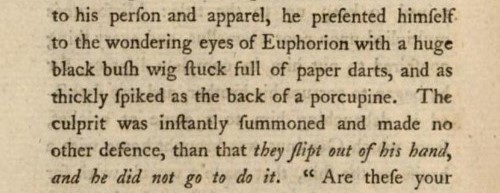


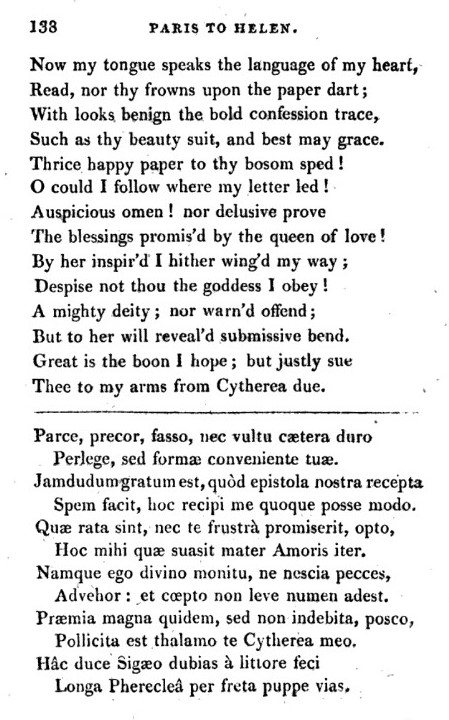
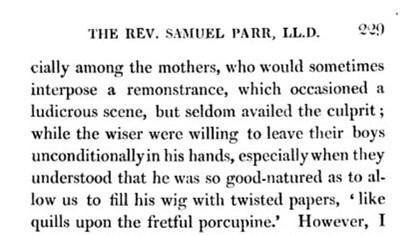
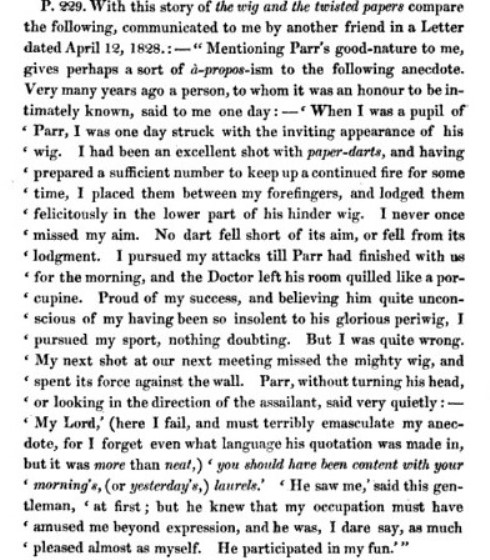
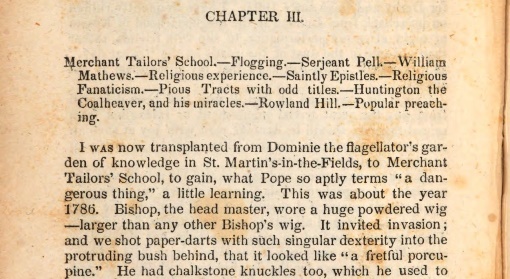
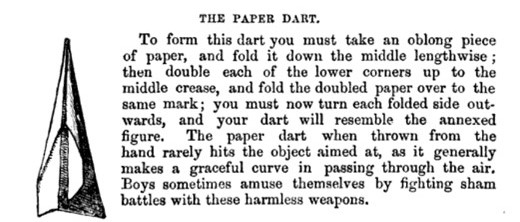 ,
, 
